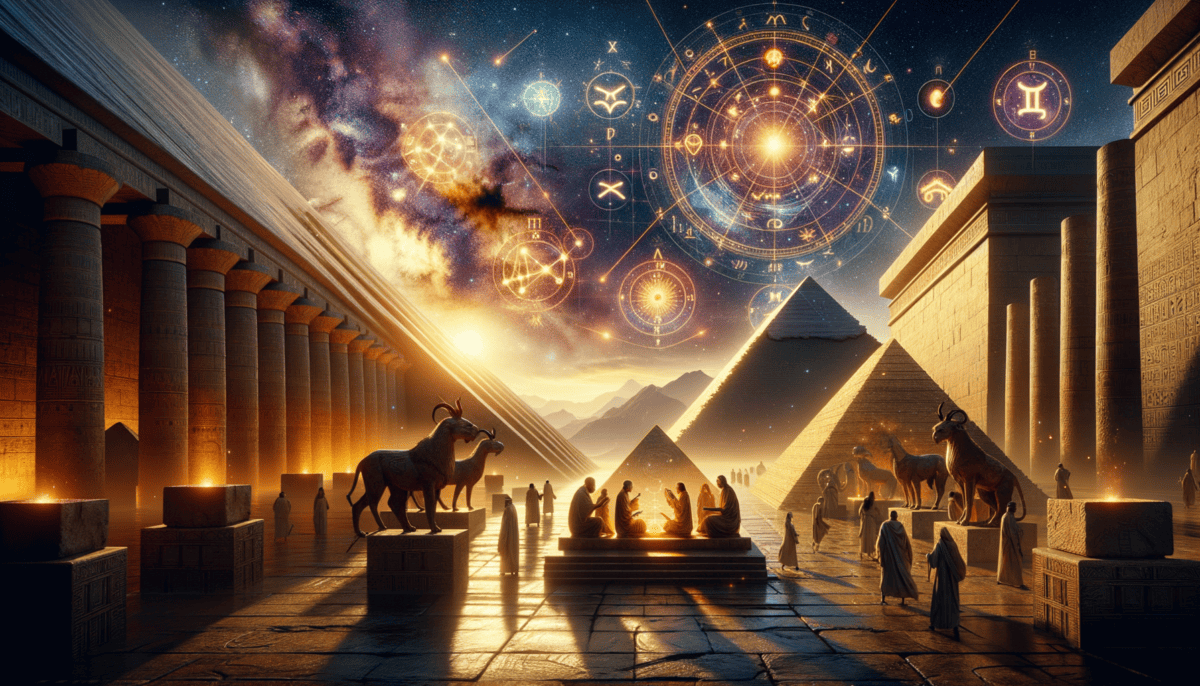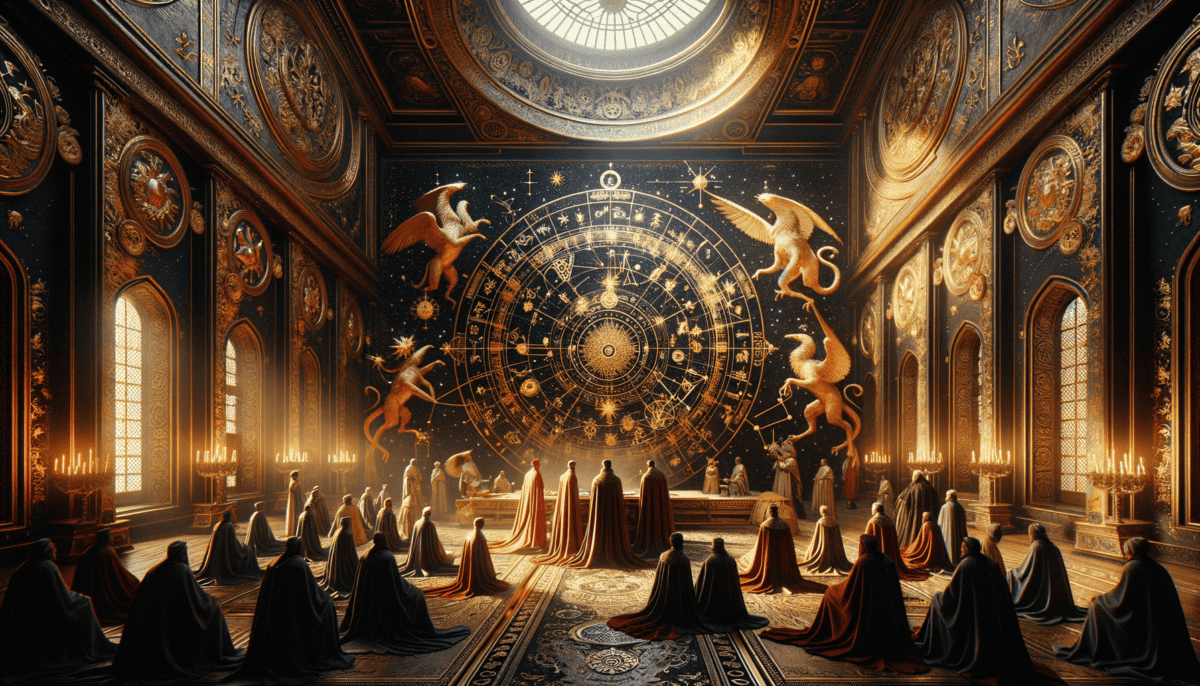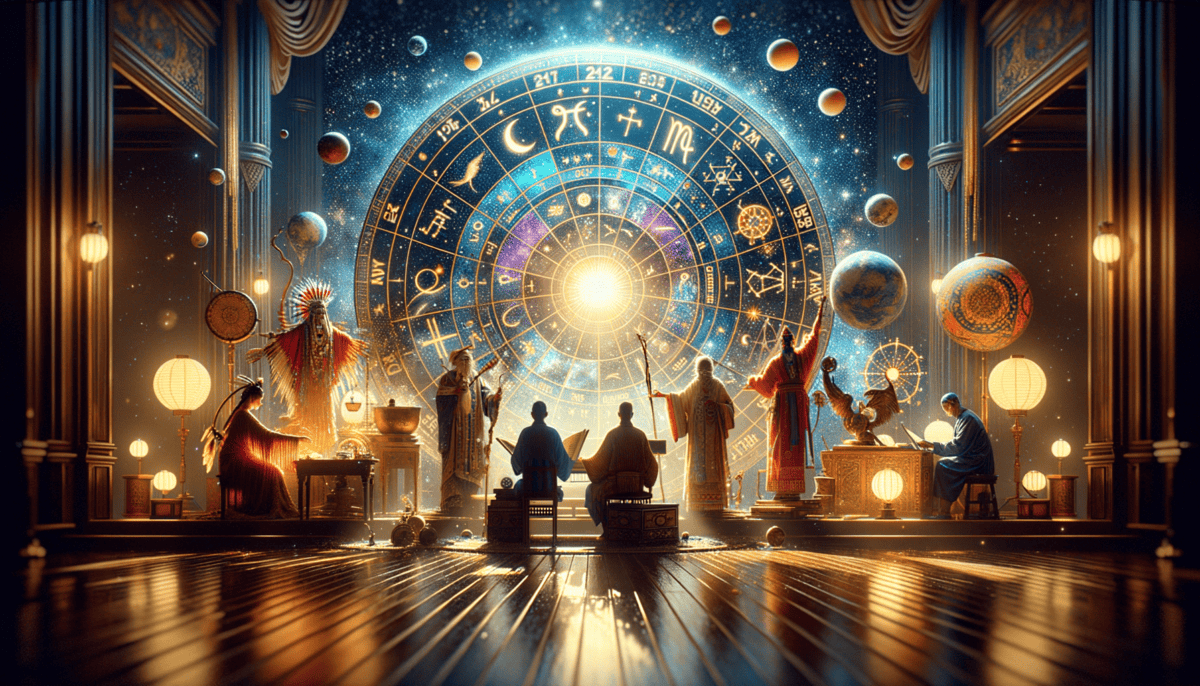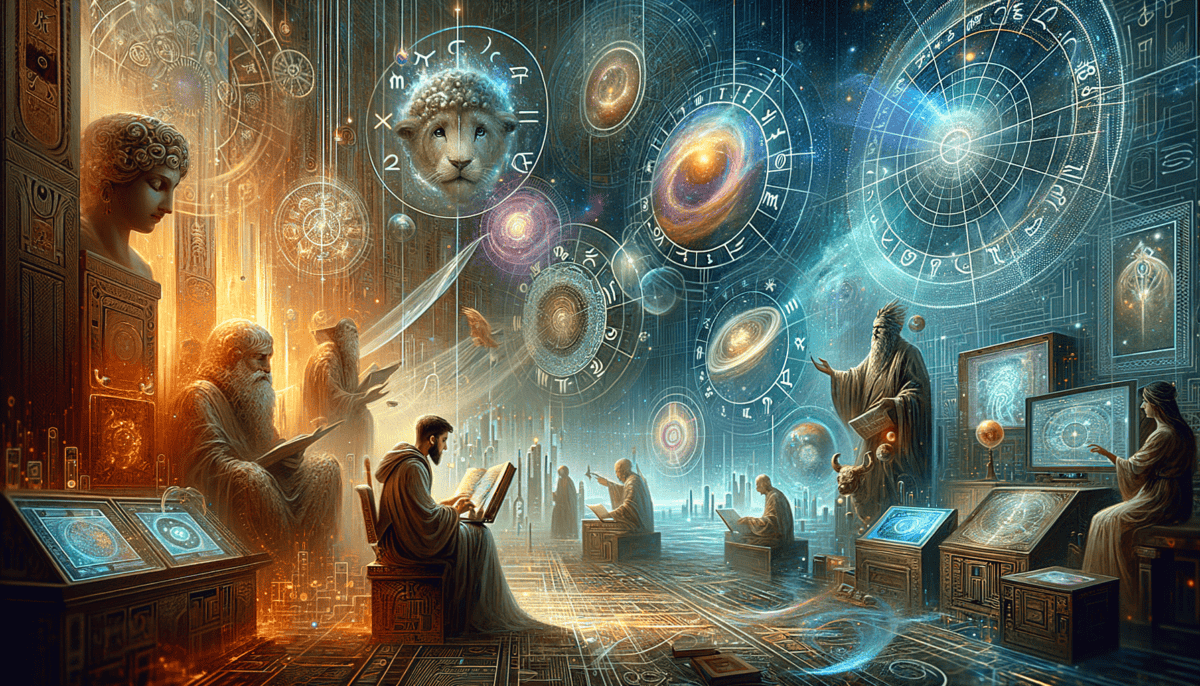The Ancient Stargazers
Long ago, in a land between two big rivers, people looked up at the night sky with wonder. The stars twinkled like tiny diamonds, and the moon glowed like a silver coin. This special place was called Mesopotamia, where the very first stargazers lived.
Maya, a young girl with curious eyes, sat beside her grandfather on a warm evening. They were sitting on top of their mud-brick house, which had a flat roof perfect for watching the stars.
"Grandfather, why do you watch the stars every night?" Maya asked, pulling her wool blanket closer.
Her grandfather smiled and pointed to the bright dots above. "The stars tell stories, little one. Our people have watched them for thousands of years."
Maya's grandfather was a special person called an astronomer. He and his friends built tall towers called ziggurats. From these towers, they could see the stars better. They wrote down everything they saw using special marks on clay tablets.
One night, Maya noticed something different in the sky. "Grandfather, that bright star is moving!"
"Ah, that's not a star, Maya. That's what we call a planet. It moves across the sky in a special way. We think these movements can tell us about things that will happen on Earth."
The people of Mesopotamia believed the stars and planets were connected to everything in their lives:
• When to plant crops
• What the weather would be like
• If good or bad things might happen
Maya learned that different stars made pictures in the sky. Her grandfather showed her how to find the Bull, the Lion, and the Twins – shapes we still look for today.
“The stars are like a big map,” Grandfather explained. “They help us know when seasons change and guide travelers at night.”
Every evening, more people joined Maya and her grandfather on their rooftop. They brought sweet dates to eat while they learned about the stars. Some wrote down what they saw on clay tablets, while others drew maps of the star patterns.
"Will I be a stargazer too?" Maya asked one night, her eyes sparkling with excitement.
Her grandfather hugged her close. "You already are, little one. Every time you look up and wonder about the stars, you're carrying on a tradition that's as old as our city walls."
Maya smiled and kept watching. She noticed how some stars seemed to make a path across the sky. These special paths would later help other people learn about the stars too.
As the night grew deeper, Maya snuggled closer to her grandfather. The cool desert breeze carried the scent of night-blooming jasmine. Above them, the stars continued their ancient dance across the sky, just as they had for thousands of years before, and would for thousands of years to come.
"Tell me more about the stars, Grandfather," Maya whispered, and he began another story about the mysteries written in the night sky.
Celestial Wisdom of Egypt and Greece
The warm sun shined down on the banks of the Nile River. Amara, a young Egyptian girl, watched as boats sailed by with their white sails puffed up like clouds.
“Papa, why are the priests always looking at the sky?” Amara asked her father, who was a temple scribe.
“They’re watching for Sirius, the brightest star,” he replied with a smile. “When it appears, it tells us the Nile will flood soon.”
In Egypt, the stars were very important. The priests built special temples that lined up with the sunrise at certain times of the year. They used these temples like giant calendars!
One day, Amara met Helena, a girl from Greece who came on a trading ship. They sat by the river and shared stories about the stars.
“In Greece, we have special star pictures too!” Helena said excitedly. “We call them zodiac signs. Each one tells a different story!”
The Greek zodiac signs were:
• Aries the Ram
• Taurus the Bull
• Gemini the Twins
• Cancer the Crab
• Leo the Lion
• Virgo the Maiden
• Libra the Scales
• Scorpio the Scorpion
• Sagittarius the Archer
• Capricorn the Goat
• Aquarius the Water Bearer
• Pisces the Fish
Amara’s eyes grew wide. “We have similar pictures in our temples! But we see them differently.”
“That’s what makes star watching special,” Helena explained. “Different people see different stories in the same stars!”
The two girls spent many evenings sharing their star stories. Helena told Amara about Greek thinkers like Ptolemy, who wrote big books about the stars. Amara shared how Egyptian priests used star patterns to know when to plant crops.
“Look!” Amara pointed to the sky one evening. “The star patterns are moving!”
Helena nodded. “My teacher says the sky moves in circles, like a big wheel. Each season brings different stars.”
Together, they learned how both their peoples used the stars to:
– Tell time at night
– Know when seasons would change
– Guide ships across the sea
– Plan special celebrations
“The stars connect all of us,” Amara said. “Even though we’re from different places, we see the same sky.”
As the sun set each day, Amara and Helena would meet by the river. They would point out star patterns and share new stories they learned. Their friendship showed how people everywhere could learn from each other by watching the same stars.
The Egyptian priests and Greek thinkers kept writing down what they learned about the stars. They didn’t know it then, but their star maps and stories would help people for thousands of years to come.
One night, as they watched the stars twinkle above the Nile, Helena turned to Amara. “Promise we’ll always remember our star stories?”
“Always,” Amara smiled. “The stars will remind us.”
Royal Stargazers
The palace halls gleamed with golden light as Maya, the young royal astrologer, hurried through the marble corridors. Her star charts rustled in her arms as she made her way to meet the Emperor.
“Your Majesty,” Maya bowed, spreading her charts on the ornate table. “The stars have important news tonight!”
The Emperor leaned forward, his eyes bright with interest. “Tell me, what do the heavens say?”
“See this bright star pattern?” Maya pointed to her chart. “It shows the best time to plant the royal gardens. And here,” she moved her finger, “this tells us when to hold the spring festival.”
In those days, kings and queens always asked their star readers before making big choices. They wanted to know:
• When to plant crops
• Good days for parties
• Safe times to travel
• Lucky days for important meetings
“But Maya,” asked the Emperor’s daughter, Princess Lily, who was watching from nearby. “How do you know what the stars mean?”
“Each star pattern tells a story,” Maya explained with a smile. “Just like reading a book in the sky!”
Maya remembered how she learned to read the stars. Her teacher, old Master Chen, would tell exciting stories about famous rulers who used the stars as guides.
“Once, a queen saved her whole kingdom because she listened to her star reader’s warning about a coming storm!”
Princess Lily loved learning about the stars. Every night, she would join Maya on the palace roof to watch the sky.
“Look there!” Maya pointed. “That bright star is called the King’s Star. When it shines strongest, it means good luck for the kingdom.”
The Emperor trusted Maya so much that he built a special star-watching tower in the palace. It had big windows that opened to the sky and special tools for watching the stars move.
One day, a messenger rushed into the palace. “Your Majesty! Storm clouds are coming from the east!”
The Emperor turned to Maya. “What do the stars say about this?”
Maya checked her charts carefully. “The stars show it will be a gentle rain, perfect for the crops. No need to worry!”
She was right! The rain helped all the plants grow, and the people had plenty of food that year.
Princess Lily clapped her hands. “Maya, will you teach me to read the stars too?”
“Of course!” Maya smiled. “The stars have wisdom for everyone who wants to learn.”
Together, Maya and Princess Lily spent many nights learning the star patterns. They found that the same stars that guided kings and queens long ago still had many stories to tell.
As they watched shooting stars streak across the night sky, Princess Lily whispered, “Maybe someday I’ll be a star reader too.”
Maya nodded. “The stars will always be here to guide us, just like they guided rulers before us.”
The Star Scientists
In a bright university classroom, Professor Sarah Jones stood before her students. She held up an old star chart and a modern telescope picture side by side.
“Look at these two pictures,” she said with a smile. “They show how much we’ve learned about the stars!”
Tommy, a curious student in the front row, raised his hand. “But Professor, why did people think stars could tell them what would happen?”
“Well, Tommy, long ago people didn’t have computers or telescopes like we do now. They watched the sky and tried their best to understand it.”
“It’s like solving a big puzzle,” Professor Jones explained. “We keep finding new pieces!”
She clicked a button, and a big screen showed beautiful space photos. The class went “Oooooh!”
“These pictures come from our biggest telescopes. They show us things the old star watchers could never see!”
Sally, another student, bounced in her seat. “My grandma still reads horoscopes in the newspaper. Why do people still like those?”
Professor Jones nodded thoughtfully. “People still enjoy reading about star signs, even though we now know stars are actually giant balls of hot gas very far away.”
The class went to visit the university observatory. Inside, a huge telescope pointed at the sky through an opening in the roof.
“This is how we study stars today,” said Dr. Miller, the observatory director. “We use special tools to learn what stars are made of!”
The students took turns looking through the telescope. “Wow!” they exclaimed. “Everything looks so clear!”
“Did you know,” Dr. Miller added, “we can now take pictures of planets around other stars? The old star watchers would have thought that was magic!”
Back in the classroom, Professor Jones showed the class old books about astrology. “These show how people used to think about stars. It’s part of our history.”
Tommy looked at the old star charts. “They’re pretty, even if they’re not scientific.”
“That’s right,” Professor Jones agreed. “We can appreciate the old stories while learning the amazing things science tells us about space.”
She turned on a space video. “Today, we have astronauts living in space! They can see the stars without looking through our air.”
The class watched in wonder as astronauts floated past stars that looked brighter than ever.
“Remember,” Professor Jones said, “every time we learn something new about space, we add to human knowledge. That’s what science is all about!”
As the students left class that day, they looked up at the sky with new eyes. They knew that while the old star stories were fun, the real science of stars was even more exciting!
Sally stopped to look up at the afternoon sky. “I can’t wait until tonight to see the stars again. Now I know what they really are!”
Star Stories Around the World
Maya sat cross-legged on her colorful carpet, listening to her grandmother tell stories about the stars. The warm evening breeze carried the scent of jasmine through the open window.
“In India,” Grandmother began, her eyes twinkling, “we see different pictures in the stars than people in other places do.”
Maya leaned forward eagerly. “Really? What kind of pictures, Grandma?”
“Well, where some people see a bear in the sky, we might see a wise sage sitting in meditation.”
“Tell me more stories from other places!” Maya bounced excitedly.
Grandmother opened a big book with pictures from around the world. “Let’s take a trip around the globe!”
“In China, they tell stories about the Jade Emperor in the sky. He watches over everyone from his starry palace.”
Maya’s eyes grew wide as she looked at the beautiful Chinese star maps.
“And in Africa,” Grandmother continued, “many people see the stars as the eyes of their ancestors watching over them.”
• Native Americans saw the Big Dipper as a giant bear
• Australian Aboriginal people saw dark spaces between stars as special shapes
• Japanese stories talk about a river of stars in the sky
• African tribes used stars to know when to plant crops
“What about in South America?” Maya asked, pointing to a picture of ancient pyramids.
“The Mayans were very good at watching the stars,” Grandmother explained. “They built special buildings to watch the sky!”
Maya drew star patterns in her notebook. “Each picture tells a different story!”
“That’s right,” smiled Grandmother. “In Hawaii, sailors used stars to find their way across the big ocean.”
“How did they do that?” Maya asked, drawing little boats under her star pictures.
“They learned special star paths from their teachers. These paths helped them find islands in the huge ocean.”
Maya’s friend Li came to visit. Her family was from China. “My mom says the stars make pictures of a sheep and a horse!”
“In my family,” Maya shared, “we see different shapes. Isn’t it cool how everyone sees something special?”
The girls spent the afternoon drawing star pictures from different cultures. They made up their own stories too.
“The stars connect all of us,” Grandmother said softly. “No matter where we live, we all share the same sky.”
That night, Maya and Li lay in the backyard looking up at the stars. They took turns pointing out shapes they could see.
“I see a dancing elephant!” giggled Maya.
“I see a flying dragon!” Li pointed to a line of bright stars.
Grandmother brought them hot chocolate. “Every star story is special,” she said. “They help us remember that we’re all part of one big world family.”
The girls sipped their drinks and watched shooting stars streak across the sky. They felt connected to all the people around the world who were looking up at the same stars.
“Tomorrow,” Maya whispered to Li, “let’s learn more star stories from other places!”
Stars in Your Pocket
Maya pulled out her new tablet, her eyes sparkling with excitement. “Look what I got for my birthday!” she showed Li. “It’s a star-finding app!”
“Cool!” Li peered at the screen. “How does it work?”
Maya held up the tablet to the sky. The screen showed all the stars above them, with lines connecting them into pictures.
“It’s like having a map of the whole sky in your hands!” Maya exclaimed.
Grandmother watched from her chair, smiling. “When I was young, we only had paper star maps. Now you can learn about stars with just one tap!”
“The old ways and new ways of learning about stars are both special,” Grandmother said wisely.
Maya downloaded more star apps. Some told her when she could see planets. Others showed her what the sky looked like thousands of years ago!
• Take pictures of stars
• Learn star stories from different cultures
• Watch for shooting stars
• Find planets in the sky
“Look!” Li pointed to her phone. “My mom just sent me my daily star reading!”
Maya giggled. “My sister gets those too. She says they help her plan her day.”
“Many people still find meaning in the stars,” Grandmother explained. “They just use new tools to learn about them.”
That evening, Maya’s family hosted a star-watching party. Everyone brought their phones and tablets.
“It’s like a bridge between past and future,” said Maya’s mom, looking through a telescope.
Kids from the neighborhood shared their favorite star apps. Some showed 3D views of planets. Others had games about constellations.
“Even with all these cool gadgets,” Maya said, “the real stars are still the most beautiful.”
Li nodded. “And now we can learn star stories from everywhere in the world!”
Grandmother hugged both girls. “The stars have always brought people together. Now technology helps us share their magic with everyone.”
Maya looked up at the twinkling sky, then down at her tablet. She felt lucky to live in a time when she could learn about stars in so many ways.
That night, Maya dreamed about future children, looking up at the same stars, finding new ways to share their stories.
The next morning, she wrote in her diary: “The stars are like old friends. No matter how we learn about them – through stories, apps, or just looking up – they’re always there, twinkling and sparkling, connecting everyone under the same big sky.” ⭐ ✨
And somewhere in the vast universe, the stars continued their eternal dance, their light touching everyone – just as they had done since the very first stargazer looked up in wonder.






